Business Law Report: Contract and Consumer Law Analysis and Issues
VerifiedAdded on 2021/06/15
|12
|2492
|453
Report
AI Summary
This report delves into the intricacies of business law, specifically examining contract law and consumer law within the Australian context. It analyzes the essential elements of a valid contract, including offer, acceptance, and consideration, referencing relevant case law such as Smith v Hughes and Hyde v Wrench. The report also explores the Australian Consumer Law (ACL), focusing on consumer guarantees and prohibitions against misleading and deceptive conduct, with reference to sections 18, 56, and 260 of the ACL, as well as the case of Australian Competition and Consumer Commission v Hewlett-Packard Australia Pty Ltd. Furthermore, the report discusses the terms of a contract, differentiating between express and implied terms, and the implications of breaches of conditions and warranties, providing a comprehensive overview of the legal principles governing business transactions and consumer protection.
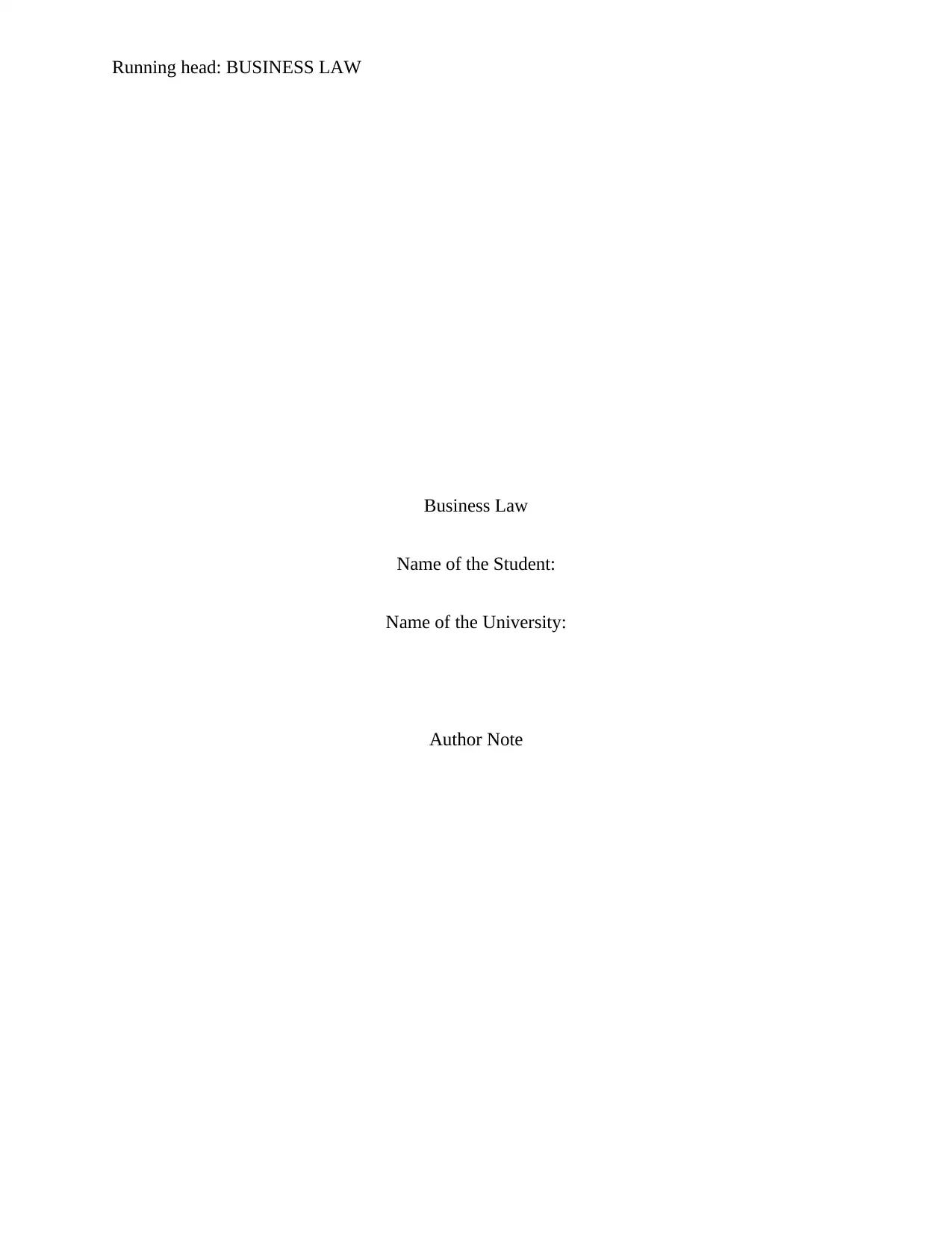
Running head: BUSINESS LAW
Business Law
Name of the Student:
Name of the University:
Author Note
Business Law
Name of the Student:
Name of the University:
Author Note
Paraphrase This Document
Need a fresh take? Get an instant paraphrase of this document with our AI Paraphraser
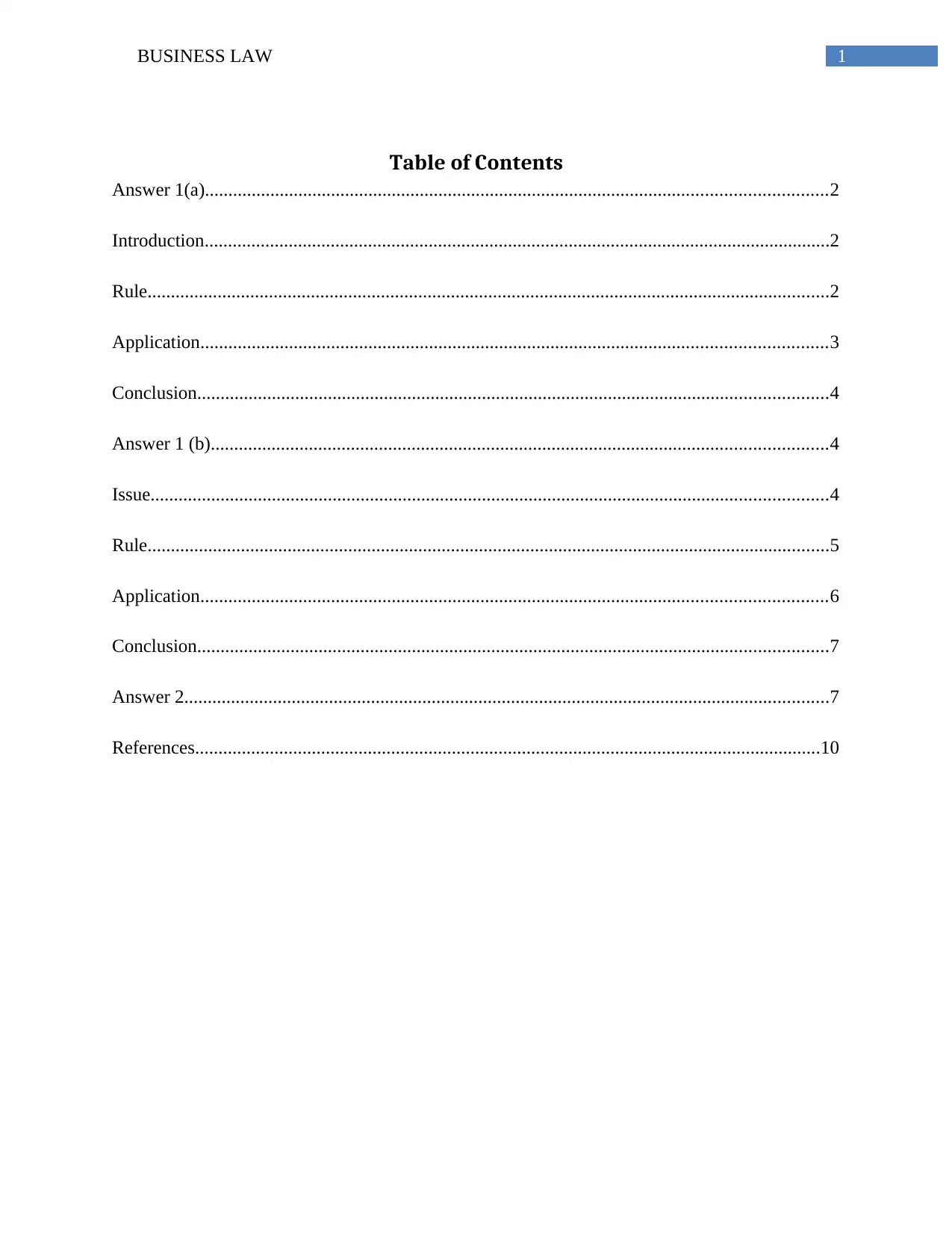
1BUSINESS LAW
Table of Contents
Answer 1(a).....................................................................................................................................2
Introduction......................................................................................................................................2
Rule..................................................................................................................................................2
Application......................................................................................................................................3
Conclusion.......................................................................................................................................4
Answer 1 (b)....................................................................................................................................4
Issue.................................................................................................................................................4
Rule..................................................................................................................................................5
Application......................................................................................................................................6
Conclusion.......................................................................................................................................7
Answer 2..........................................................................................................................................7
References......................................................................................................................................10
Table of Contents
Answer 1(a).....................................................................................................................................2
Introduction......................................................................................................................................2
Rule..................................................................................................................................................2
Application......................................................................................................................................3
Conclusion.......................................................................................................................................4
Answer 1 (b)....................................................................................................................................4
Issue.................................................................................................................................................4
Rule..................................................................................................................................................5
Application......................................................................................................................................6
Conclusion.......................................................................................................................................7
Answer 2..........................................................................................................................................7
References......................................................................................................................................10
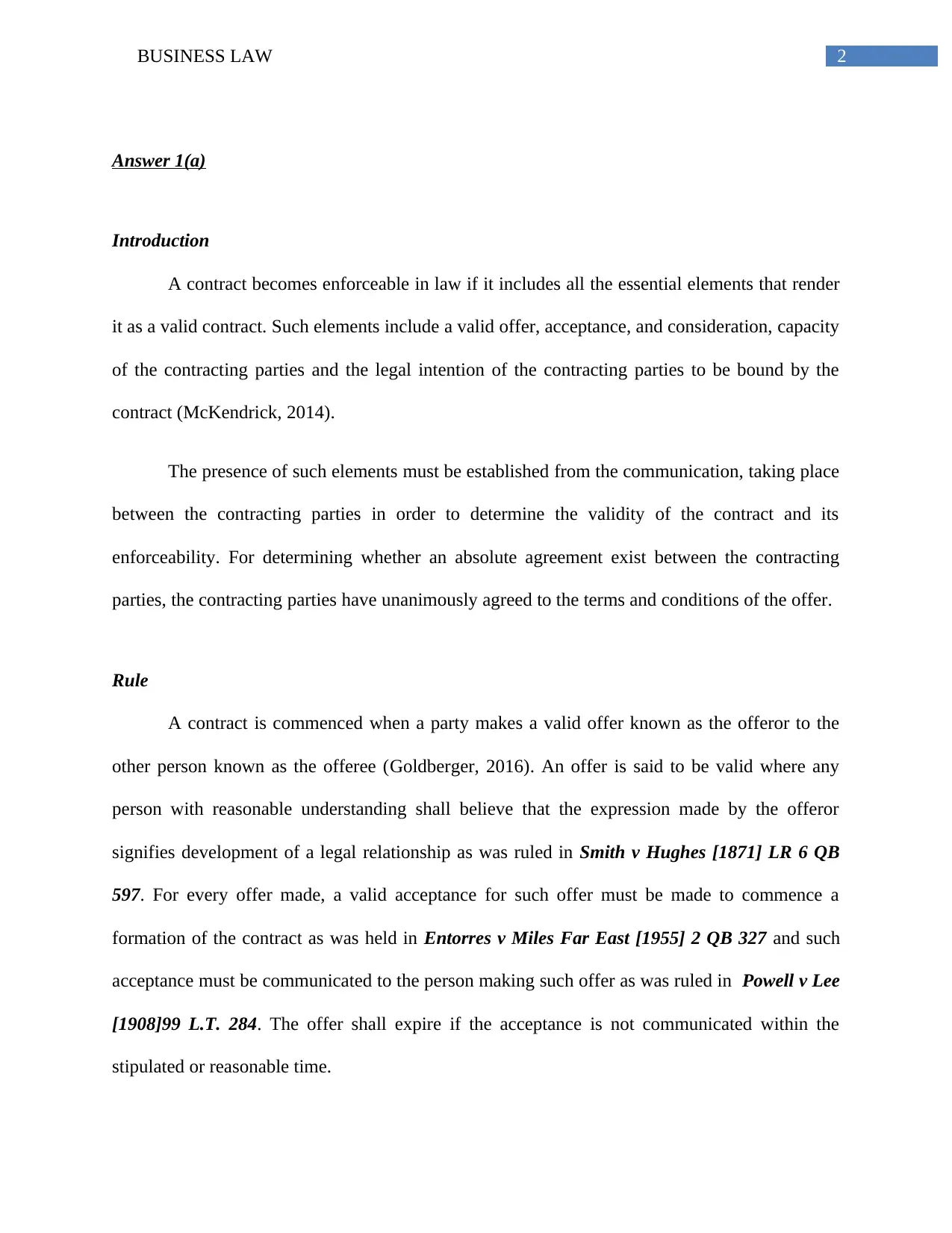
2BUSINESS LAW
Answer 1(a)
Introduction
A contract becomes enforceable in law if it includes all the essential elements that render
it as a valid contract. Such elements include a valid offer, acceptance, and consideration, capacity
of the contracting parties and the legal intention of the contracting parties to be bound by the
contract (McKendrick, 2014).
The presence of such elements must be established from the communication, taking place
between the contracting parties in order to determine the validity of the contract and its
enforceability. For determining whether an absolute agreement exist between the contracting
parties, the contracting parties have unanimously agreed to the terms and conditions of the offer.
Rule
A contract is commenced when a party makes a valid offer known as the offeror to the
other person known as the offeree (Goldberger, 2016). An offer is said to be valid where any
person with reasonable understanding shall believe that the expression made by the offeror
signifies development of a legal relationship as was ruled in Smith v Hughes [1871] LR 6 QB
597. For every offer made, a valid acceptance for such offer must be made to commence a
formation of the contract as was held in Entorres v Miles Far East [1955] 2 QB 327 and such
acceptance must be communicated to the person making such offer as was ruled in Powell v Lee
[1908]99 L.T. 284. The offer shall expire if the acceptance is not communicated within the
stipulated or reasonable time.
Answer 1(a)
Introduction
A contract becomes enforceable in law if it includes all the essential elements that render
it as a valid contract. Such elements include a valid offer, acceptance, and consideration, capacity
of the contracting parties and the legal intention of the contracting parties to be bound by the
contract (McKendrick, 2014).
The presence of such elements must be established from the communication, taking place
between the contracting parties in order to determine the validity of the contract and its
enforceability. For determining whether an absolute agreement exist between the contracting
parties, the contracting parties have unanimously agreed to the terms and conditions of the offer.
Rule
A contract is commenced when a party makes a valid offer known as the offeror to the
other person known as the offeree (Goldberger, 2016). An offer is said to be valid where any
person with reasonable understanding shall believe that the expression made by the offeror
signifies development of a legal relationship as was ruled in Smith v Hughes [1871] LR 6 QB
597. For every offer made, a valid acceptance for such offer must be made to commence a
formation of the contract as was held in Entorres v Miles Far East [1955] 2 QB 327 and such
acceptance must be communicated to the person making such offer as was ruled in Powell v Lee
[1908]99 L.T. 284. The offer shall expire if the acceptance is not communicated within the
stipulated or reasonable time.
⊘ This is a preview!⊘
Do you want full access?
Subscribe today to unlock all pages.

Trusted by 1+ million students worldwide
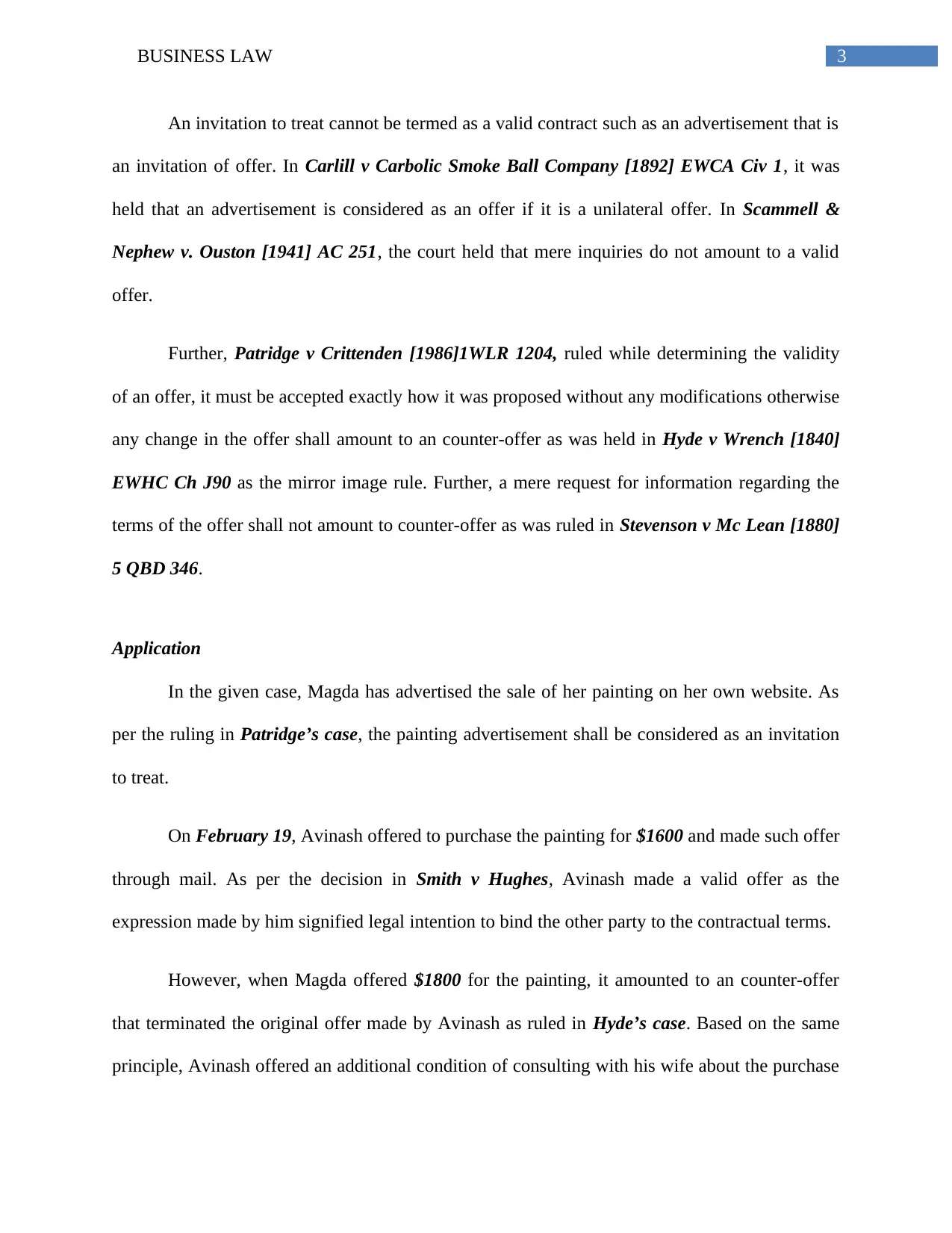
3BUSINESS LAW
An invitation to treat cannot be termed as a valid contract such as an advertisement that is
an invitation of offer. In Carlill v Carbolic Smoke Ball Company [1892] EWCA Civ 1, it was
held that an advertisement is considered as an offer if it is a unilateral offer. In Scammell &
Nephew v. Ouston [1941] AC 251, the court held that mere inquiries do not amount to a valid
offer.
Further, Patridge v Crittenden [1986]1WLR 1204, ruled while determining the validity
of an offer, it must be accepted exactly how it was proposed without any modifications otherwise
any change in the offer shall amount to an counter-offer as was held in Hyde v Wrench [1840]
EWHC Ch J90 as the mirror image rule. Further, a mere request for information regarding the
terms of the offer shall not amount to counter-offer as was ruled in Stevenson v Mc Lean [1880]
5 QBD 346.
Application
In the given case, Magda has advertised the sale of her painting on her own website. As
per the ruling in Patridge’s case, the painting advertisement shall be considered as an invitation
to treat.
On February 19, Avinash offered to purchase the painting for $1600 and made such offer
through mail. As per the decision in Smith v Hughes, Avinash made a valid offer as the
expression made by him signified legal intention to bind the other party to the contractual terms.
However, when Magda offered $1800 for the painting, it amounted to an counter-offer
that terminated the original offer made by Avinash as ruled in Hyde’s case. Based on the same
principle, Avinash offered an additional condition of consulting with his wife about the purchase
An invitation to treat cannot be termed as a valid contract such as an advertisement that is
an invitation of offer. In Carlill v Carbolic Smoke Ball Company [1892] EWCA Civ 1, it was
held that an advertisement is considered as an offer if it is a unilateral offer. In Scammell &
Nephew v. Ouston [1941] AC 251, the court held that mere inquiries do not amount to a valid
offer.
Further, Patridge v Crittenden [1986]1WLR 1204, ruled while determining the validity
of an offer, it must be accepted exactly how it was proposed without any modifications otherwise
any change in the offer shall amount to an counter-offer as was held in Hyde v Wrench [1840]
EWHC Ch J90 as the mirror image rule. Further, a mere request for information regarding the
terms of the offer shall not amount to counter-offer as was ruled in Stevenson v Mc Lean [1880]
5 QBD 346.
Application
In the given case, Magda has advertised the sale of her painting on her own website. As
per the ruling in Patridge’s case, the painting advertisement shall be considered as an invitation
to treat.
On February 19, Avinash offered to purchase the painting for $1600 and made such offer
through mail. As per the decision in Smith v Hughes, Avinash made a valid offer as the
expression made by him signified legal intention to bind the other party to the contractual terms.
However, when Magda offered $1800 for the painting, it amounted to an counter-offer
that terminated the original offer made by Avinash as ruled in Hyde’s case. Based on the same
principle, Avinash offered an additional condition of consulting with his wife about the purchase
Paraphrase This Document
Need a fresh take? Get an instant paraphrase of this document with our AI Paraphraser
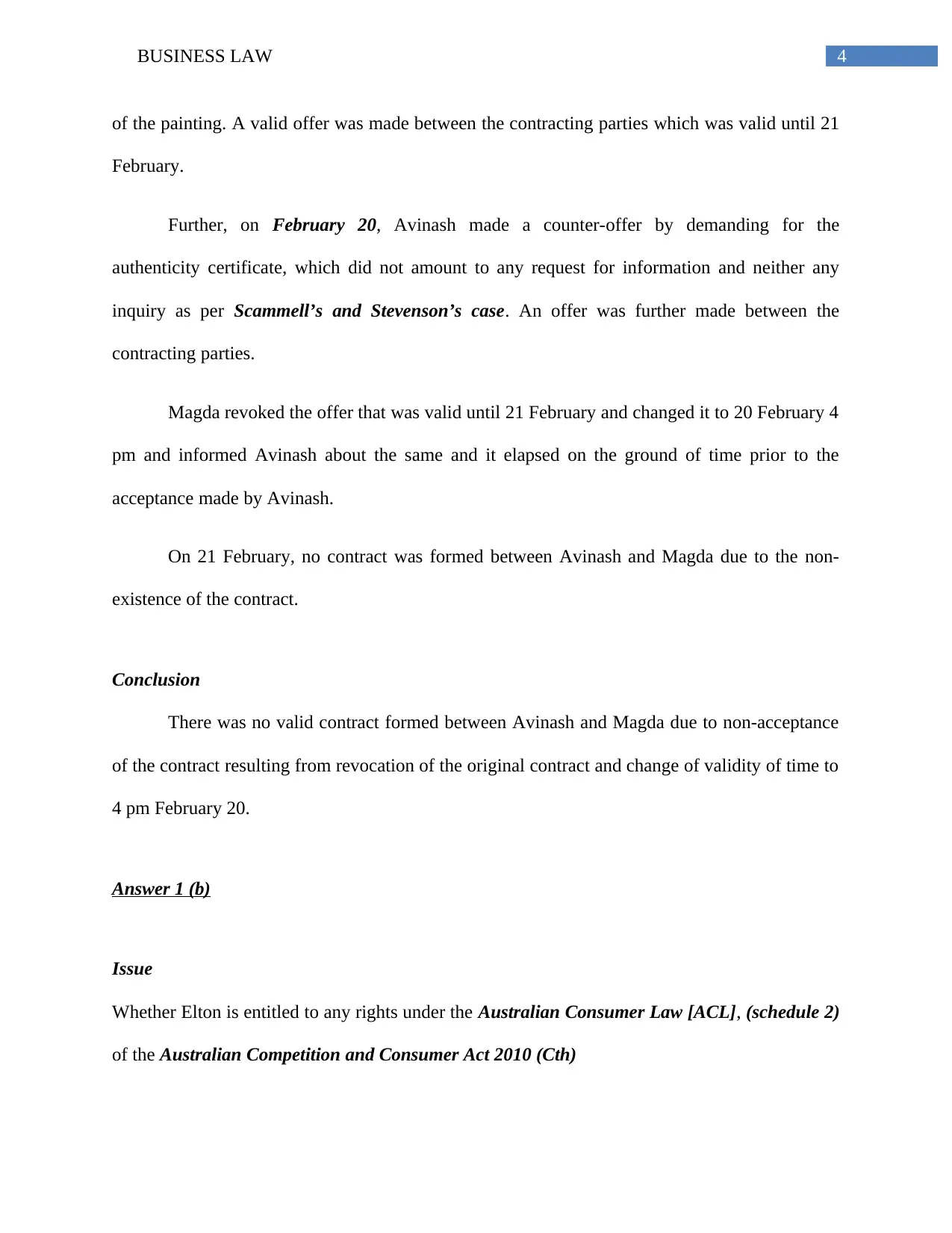
4BUSINESS LAW
of the painting. A valid offer was made between the contracting parties which was valid until 21
February.
Further, on February 20, Avinash made a counter-offer by demanding for the
authenticity certificate, which did not amount to any request for information and neither any
inquiry as per Scammell’s and Stevenson’s case. An offer was further made between the
contracting parties.
Magda revoked the offer that was valid until 21 February and changed it to 20 February 4
pm and informed Avinash about the same and it elapsed on the ground of time prior to the
acceptance made by Avinash.
On 21 February, no contract was formed between Avinash and Magda due to the non-
existence of the contract.
Conclusion
There was no valid contract formed between Avinash and Magda due to non-acceptance
of the contract resulting from revocation of the original contract and change of validity of time to
4 pm February 20.
Answer 1 (b)
Issue
Whether Elton is entitled to any rights under the Australian Consumer Law [ACL], (schedule 2)
of the Australian Competition and Consumer Act 2010 (Cth)
of the painting. A valid offer was made between the contracting parties which was valid until 21
February.
Further, on February 20, Avinash made a counter-offer by demanding for the
authenticity certificate, which did not amount to any request for information and neither any
inquiry as per Scammell’s and Stevenson’s case. An offer was further made between the
contracting parties.
Magda revoked the offer that was valid until 21 February and changed it to 20 February 4
pm and informed Avinash about the same and it elapsed on the ground of time prior to the
acceptance made by Avinash.
On 21 February, no contract was formed between Avinash and Magda due to the non-
existence of the contract.
Conclusion
There was no valid contract formed between Avinash and Magda due to non-acceptance
of the contract resulting from revocation of the original contract and change of validity of time to
4 pm February 20.
Answer 1 (b)
Issue
Whether Elton is entitled to any rights under the Australian Consumer Law [ACL], (schedule 2)
of the Australian Competition and Consumer Act 2010 (Cth)
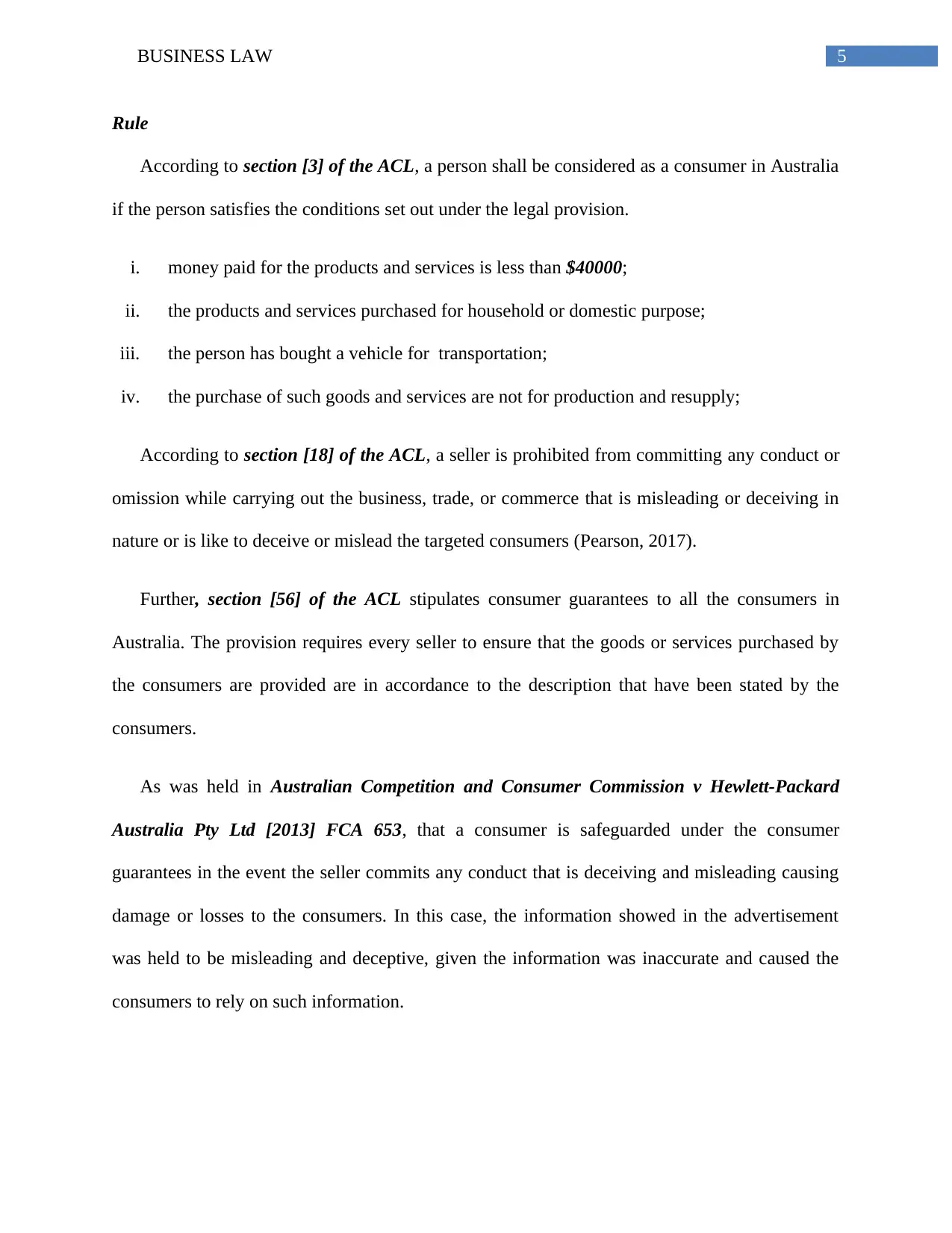
5BUSINESS LAW
Rule
According to section [3] of the ACL, a person shall be considered as a consumer in Australia
if the person satisfies the conditions set out under the legal provision.
i. money paid for the products and services is less than $40000;
ii. the products and services purchased for household or domestic purpose;
iii. the person has bought a vehicle for transportation;
iv. the purchase of such goods and services are not for production and resupply;
According to section [18] of the ACL, a seller is prohibited from committing any conduct or
omission while carrying out the business, trade, or commerce that is misleading or deceiving in
nature or is like to deceive or mislead the targeted consumers (Pearson, 2017).
Further, section [56] of the ACL stipulates consumer guarantees to all the consumers in
Australia. The provision requires every seller to ensure that the goods or services purchased by
the consumers are provided are in accordance to the description that have been stated by the
consumers.
As was held in Australian Competition and Consumer Commission v Hewlett-Packard
Australia Pty Ltd [2013] FCA 653, that a consumer is safeguarded under the consumer
guarantees in the event the seller commits any conduct that is deceiving and misleading causing
damage or losses to the consumers. In this case, the information showed in the advertisement
was held to be misleading and deceptive, given the information was inaccurate and caused the
consumers to rely on such information.
Rule
According to section [3] of the ACL, a person shall be considered as a consumer in Australia
if the person satisfies the conditions set out under the legal provision.
i. money paid for the products and services is less than $40000;
ii. the products and services purchased for household or domestic purpose;
iii. the person has bought a vehicle for transportation;
iv. the purchase of such goods and services are not for production and resupply;
According to section [18] of the ACL, a seller is prohibited from committing any conduct or
omission while carrying out the business, trade, or commerce that is misleading or deceiving in
nature or is like to deceive or mislead the targeted consumers (Pearson, 2017).
Further, section [56] of the ACL stipulates consumer guarantees to all the consumers in
Australia. The provision requires every seller to ensure that the goods or services purchased by
the consumers are provided are in accordance to the description that have been stated by the
consumers.
As was held in Australian Competition and Consumer Commission v Hewlett-Packard
Australia Pty Ltd [2013] FCA 653, that a consumer is safeguarded under the consumer
guarantees in the event the seller commits any conduct that is deceiving and misleading causing
damage or losses to the consumers. In this case, the information showed in the advertisement
was held to be misleading and deceptive, given the information was inaccurate and caused the
consumers to rely on such information.
⊘ This is a preview!⊘
Do you want full access?
Subscribe today to unlock all pages.

Trusted by 1+ million students worldwide
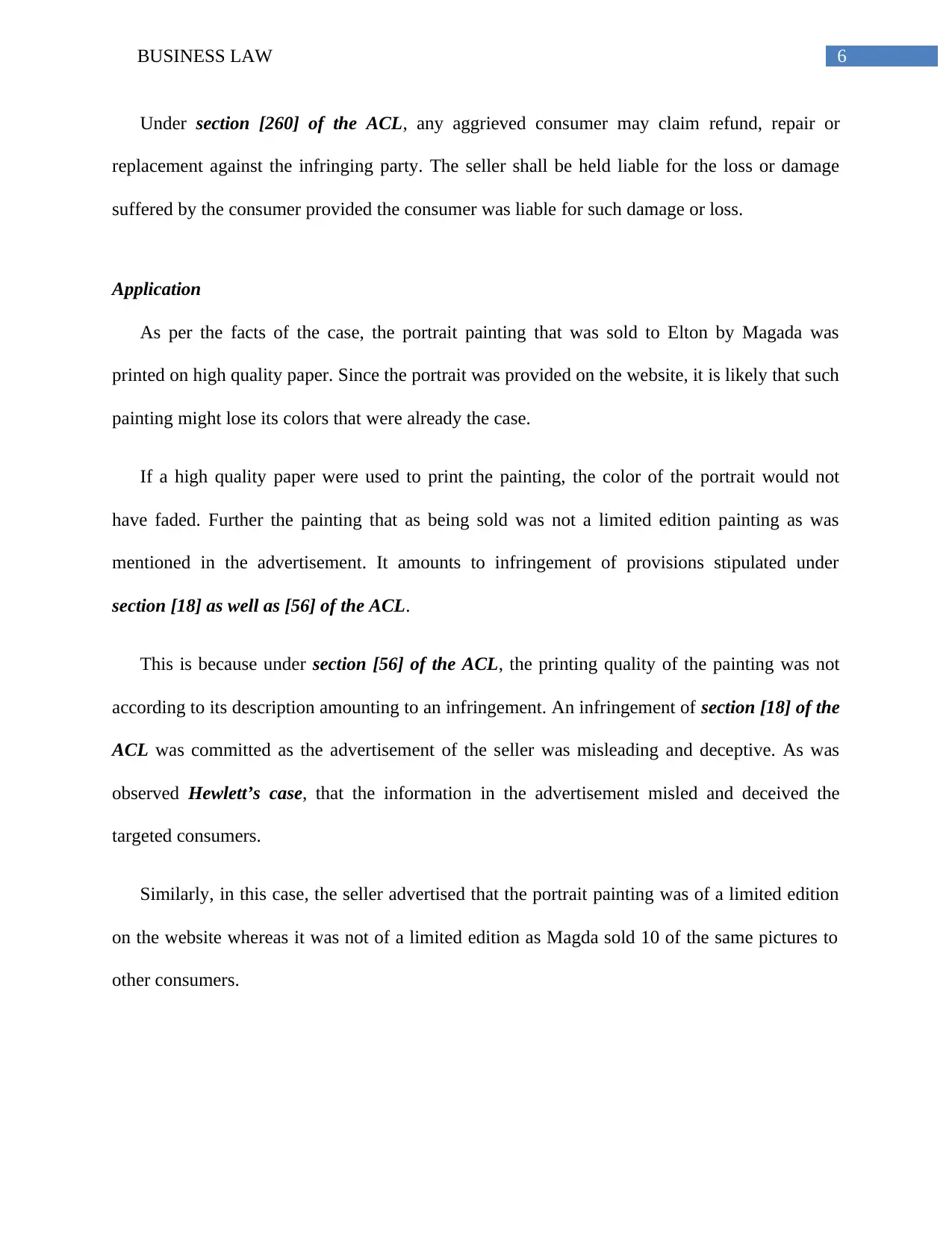
6BUSINESS LAW
Under section [260] of the ACL, any aggrieved consumer may claim refund, repair or
replacement against the infringing party. The seller shall be held liable for the loss or damage
suffered by the consumer provided the consumer was liable for such damage or loss.
Application
As per the facts of the case, the portrait painting that was sold to Elton by Magada was
printed on high quality paper. Since the portrait was provided on the website, it is likely that such
painting might lose its colors that were already the case.
If a high quality paper were used to print the painting, the color of the portrait would not
have faded. Further the painting that as being sold was not a limited edition painting as was
mentioned in the advertisement. It amounts to infringement of provisions stipulated under
section [18] as well as [56] of the ACL.
This is because under section [56] of the ACL, the printing quality of the painting was not
according to its description amounting to an infringement. An infringement of section [18] of the
ACL was committed as the advertisement of the seller was misleading and deceptive. As was
observed Hewlett’s case, that the information in the advertisement misled and deceived the
targeted consumers.
Similarly, in this case, the seller advertised that the portrait painting was of a limited edition
on the website whereas it was not of a limited edition as Magda sold 10 of the same pictures to
other consumers.
Under section [260] of the ACL, any aggrieved consumer may claim refund, repair or
replacement against the infringing party. The seller shall be held liable for the loss or damage
suffered by the consumer provided the consumer was liable for such damage or loss.
Application
As per the facts of the case, the portrait painting that was sold to Elton by Magada was
printed on high quality paper. Since the portrait was provided on the website, it is likely that such
painting might lose its colors that were already the case.
If a high quality paper were used to print the painting, the color of the portrait would not
have faded. Further the painting that as being sold was not a limited edition painting as was
mentioned in the advertisement. It amounts to infringement of provisions stipulated under
section [18] as well as [56] of the ACL.
This is because under section [56] of the ACL, the printing quality of the painting was not
according to its description amounting to an infringement. An infringement of section [18] of the
ACL was committed as the advertisement of the seller was misleading and deceptive. As was
observed Hewlett’s case, that the information in the advertisement misled and deceived the
targeted consumers.
Similarly, in this case, the seller advertised that the portrait painting was of a limited edition
on the website whereas it was not of a limited edition as Magda sold 10 of the same pictures to
other consumers.
Paraphrase This Document
Need a fresh take? Get an instant paraphrase of this document with our AI Paraphraser
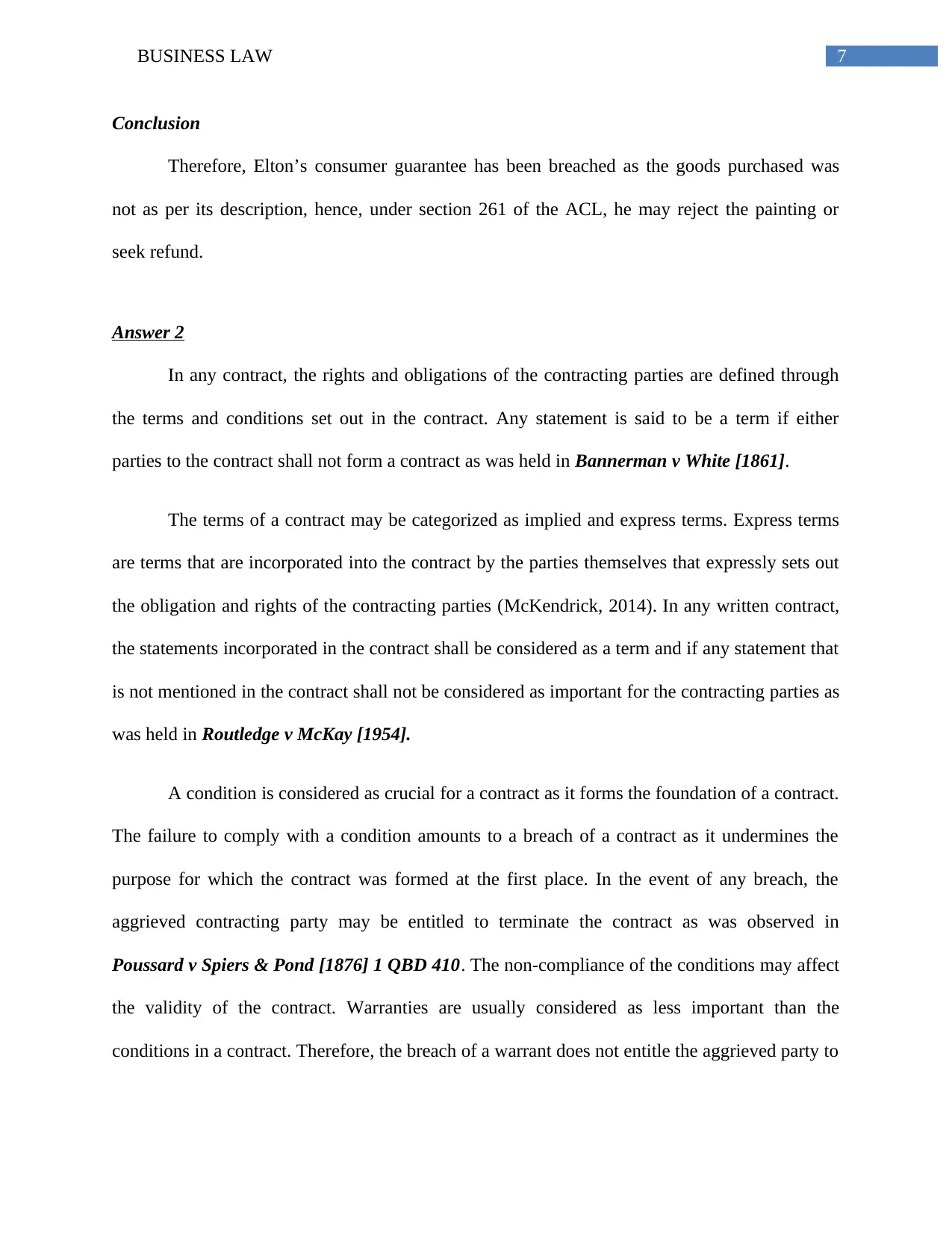
7BUSINESS LAW
Conclusion
Therefore, Elton’s consumer guarantee has been breached as the goods purchased was
not as per its description, hence, under section 261 of the ACL, he may reject the painting or
seek refund.
Answer 2
In any contract, the rights and obligations of the contracting parties are defined through
the terms and conditions set out in the contract. Any statement is said to be a term if either
parties to the contract shall not form a contract as was held in Bannerman v White [1861].
The terms of a contract may be categorized as implied and express terms. Express terms
are terms that are incorporated into the contract by the parties themselves that expressly sets out
the obligation and rights of the contracting parties (McKendrick, 2014). In any written contract,
the statements incorporated in the contract shall be considered as a term and if any statement that
is not mentioned in the contract shall not be considered as important for the contracting parties as
was held in Routledge v McKay [1954].
A condition is considered as crucial for a contract as it forms the foundation of a contract.
The failure to comply with a condition amounts to a breach of a contract as it undermines the
purpose for which the contract was formed at the first place. In the event of any breach, the
aggrieved contracting party may be entitled to terminate the contract as was observed in
Poussard v Spiers & Pond [1876] 1 QBD 410. The non-compliance of the conditions may affect
the validity of the contract. Warranties are usually considered as less important than the
conditions in a contract. Therefore, the breach of a warrant does not entitle the aggrieved party to
Conclusion
Therefore, Elton’s consumer guarantee has been breached as the goods purchased was
not as per its description, hence, under section 261 of the ACL, he may reject the painting or
seek refund.
Answer 2
In any contract, the rights and obligations of the contracting parties are defined through
the terms and conditions set out in the contract. Any statement is said to be a term if either
parties to the contract shall not form a contract as was held in Bannerman v White [1861].
The terms of a contract may be categorized as implied and express terms. Express terms
are terms that are incorporated into the contract by the parties themselves that expressly sets out
the obligation and rights of the contracting parties (McKendrick, 2014). In any written contract,
the statements incorporated in the contract shall be considered as a term and if any statement that
is not mentioned in the contract shall not be considered as important for the contracting parties as
was held in Routledge v McKay [1954].
A condition is considered as crucial for a contract as it forms the foundation of a contract.
The failure to comply with a condition amounts to a breach of a contract as it undermines the
purpose for which the contract was formed at the first place. In the event of any breach, the
aggrieved contracting party may be entitled to terminate the contract as was observed in
Poussard v Spiers & Pond [1876] 1 QBD 410. The non-compliance of the conditions may affect
the validity of the contract. Warranties are usually considered as less important than the
conditions in a contract. Therefore, the breach of a warrant does not entitle the aggrieved party to
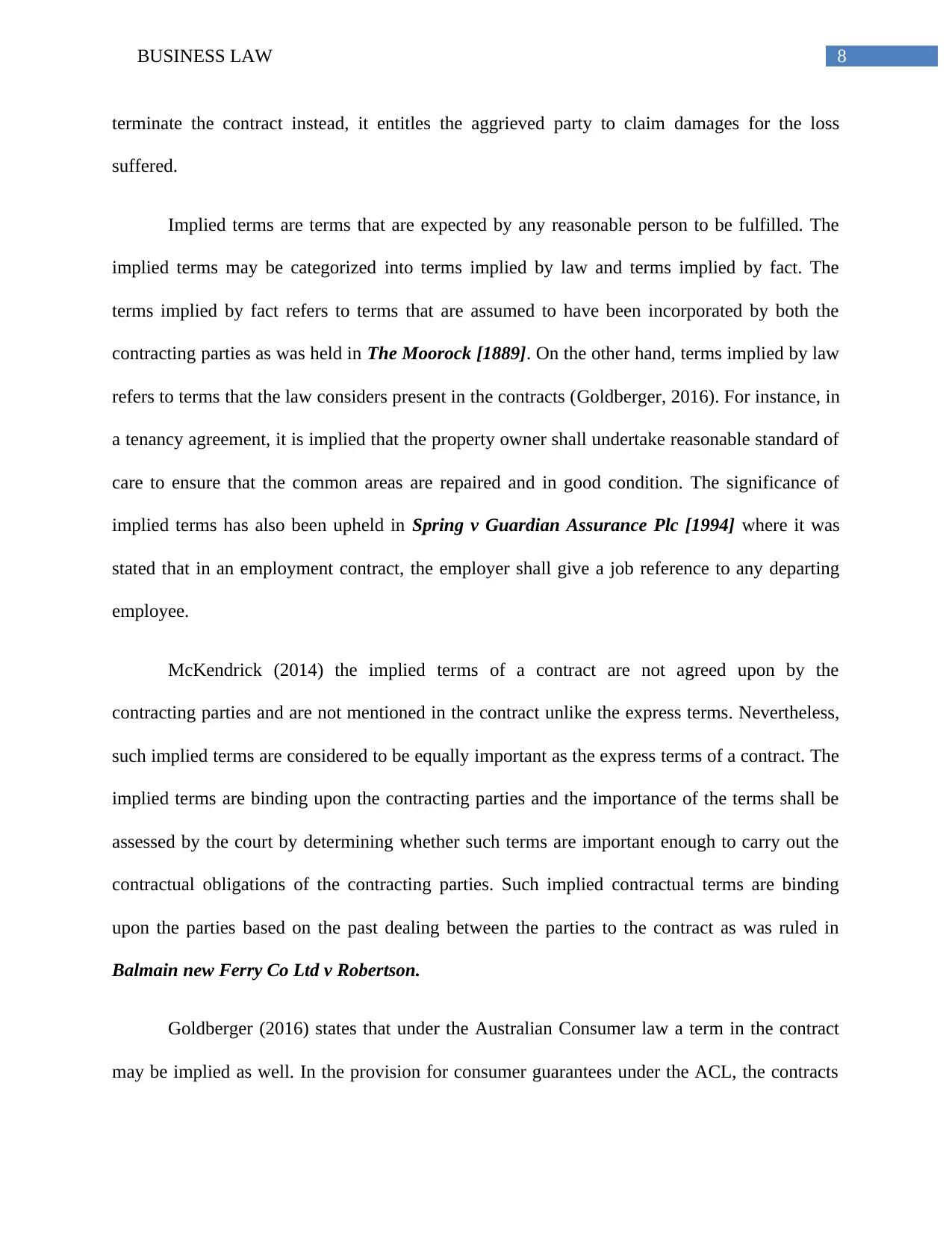
8BUSINESS LAW
terminate the contract instead, it entitles the aggrieved party to claim damages for the loss
suffered.
Implied terms are terms that are expected by any reasonable person to be fulfilled. The
implied terms may be categorized into terms implied by law and terms implied by fact. The
terms implied by fact refers to terms that are assumed to have been incorporated by both the
contracting parties as was held in The Moorock [1889]. On the other hand, terms implied by law
refers to terms that the law considers present in the contracts (Goldberger, 2016). For instance, in
a tenancy agreement, it is implied that the property owner shall undertake reasonable standard of
care to ensure that the common areas are repaired and in good condition. The significance of
implied terms has also been upheld in Spring v Guardian Assurance Plc [1994] where it was
stated that in an employment contract, the employer shall give a job reference to any departing
employee.
McKendrick (2014) the implied terms of a contract are not agreed upon by the
contracting parties and are not mentioned in the contract unlike the express terms. Nevertheless,
such implied terms are considered to be equally important as the express terms of a contract. The
implied terms are binding upon the contracting parties and the importance of the terms shall be
assessed by the court by determining whether such terms are important enough to carry out the
contractual obligations of the contracting parties. Such implied contractual terms are binding
upon the parties based on the past dealing between the parties to the contract as was ruled in
Balmain new Ferry Co Ltd v Robertson.
Goldberger (2016) states that under the Australian Consumer law a term in the contract
may be implied as well. In the provision for consumer guarantees under the ACL, the contracts
terminate the contract instead, it entitles the aggrieved party to claim damages for the loss
suffered.
Implied terms are terms that are expected by any reasonable person to be fulfilled. The
implied terms may be categorized into terms implied by law and terms implied by fact. The
terms implied by fact refers to terms that are assumed to have been incorporated by both the
contracting parties as was held in The Moorock [1889]. On the other hand, terms implied by law
refers to terms that the law considers present in the contracts (Goldberger, 2016). For instance, in
a tenancy agreement, it is implied that the property owner shall undertake reasonable standard of
care to ensure that the common areas are repaired and in good condition. The significance of
implied terms has also been upheld in Spring v Guardian Assurance Plc [1994] where it was
stated that in an employment contract, the employer shall give a job reference to any departing
employee.
McKendrick (2014) the implied terms of a contract are not agreed upon by the
contracting parties and are not mentioned in the contract unlike the express terms. Nevertheless,
such implied terms are considered to be equally important as the express terms of a contract. The
implied terms are binding upon the contracting parties and the importance of the terms shall be
assessed by the court by determining whether such terms are important enough to carry out the
contractual obligations of the contracting parties. Such implied contractual terms are binding
upon the parties based on the past dealing between the parties to the contract as was ruled in
Balmain new Ferry Co Ltd v Robertson.
Goldberger (2016) states that under the Australian Consumer law a term in the contract
may be implied as well. In the provision for consumer guarantees under the ACL, the contracts
⊘ This is a preview!⊘
Do you want full access?
Subscribe today to unlock all pages.

Trusted by 1+ million students worldwide
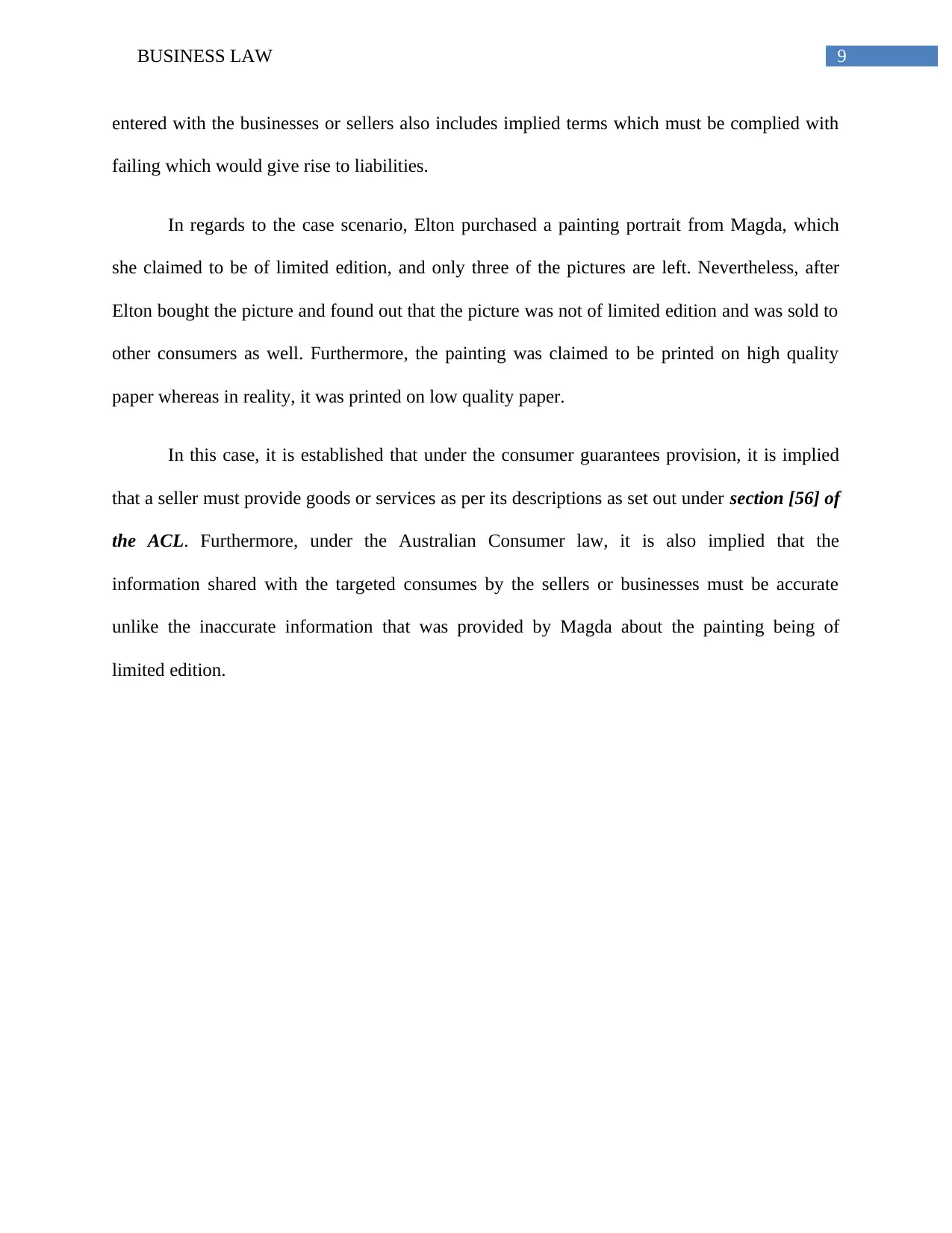
9BUSINESS LAW
entered with the businesses or sellers also includes implied terms which must be complied with
failing which would give rise to liabilities.
In regards to the case scenario, Elton purchased a painting portrait from Magda, which
she claimed to be of limited edition, and only three of the pictures are left. Nevertheless, after
Elton bought the picture and found out that the picture was not of limited edition and was sold to
other consumers as well. Furthermore, the painting was claimed to be printed on high quality
paper whereas in reality, it was printed on low quality paper.
In this case, it is established that under the consumer guarantees provision, it is implied
that a seller must provide goods or services as per its descriptions as set out under section [56] of
the ACL. Furthermore, under the Australian Consumer law, it is also implied that the
information shared with the targeted consumes by the sellers or businesses must be accurate
unlike the inaccurate information that was provided by Magda about the painting being of
limited edition.
entered with the businesses or sellers also includes implied terms which must be complied with
failing which would give rise to liabilities.
In regards to the case scenario, Elton purchased a painting portrait from Magda, which
she claimed to be of limited edition, and only three of the pictures are left. Nevertheless, after
Elton bought the picture and found out that the picture was not of limited edition and was sold to
other consumers as well. Furthermore, the painting was claimed to be printed on high quality
paper whereas in reality, it was printed on low quality paper.
In this case, it is established that under the consumer guarantees provision, it is implied
that a seller must provide goods or services as per its descriptions as set out under section [56] of
the ACL. Furthermore, under the Australian Consumer law, it is also implied that the
information shared with the targeted consumes by the sellers or businesses must be accurate
unlike the inaccurate information that was provided by Magda about the painting being of
limited edition.
Paraphrase This Document
Need a fresh take? Get an instant paraphrase of this document with our AI Paraphraser
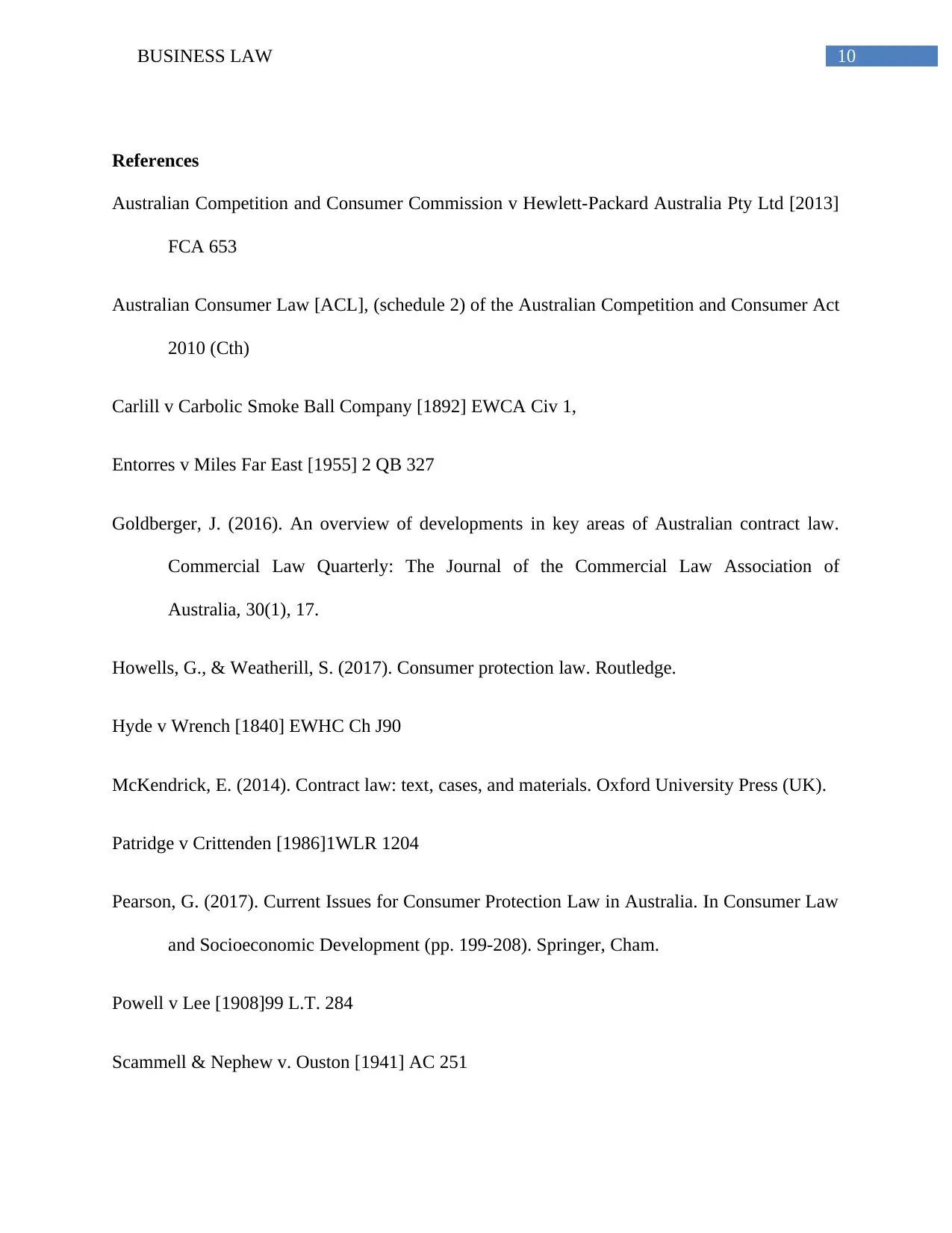
10BUSINESS LAW
References
Australian Competition and Consumer Commission v Hewlett-Packard Australia Pty Ltd [2013]
FCA 653
Australian Consumer Law [ACL], (schedule 2) of the Australian Competition and Consumer Act
2010 (Cth)
Carlill v Carbolic Smoke Ball Company [1892] EWCA Civ 1,
Entorres v Miles Far East [1955] 2 QB 327
Goldberger, J. (2016). An overview of developments in key areas of Australian contract law.
Commercial Law Quarterly: The Journal of the Commercial Law Association of
Australia, 30(1), 17.
Howells, G., & Weatherill, S. (2017). Consumer protection law. Routledge.
Hyde v Wrench [1840] EWHC Ch J90
McKendrick, E. (2014). Contract law: text, cases, and materials. Oxford University Press (UK).
Patridge v Crittenden [1986]1WLR 1204
Pearson, G. (2017). Current Issues for Consumer Protection Law in Australia. In Consumer Law
and Socioeconomic Development (pp. 199-208). Springer, Cham.
Powell v Lee [1908]99 L.T. 284
Scammell & Nephew v. Ouston [1941] AC 251
References
Australian Competition and Consumer Commission v Hewlett-Packard Australia Pty Ltd [2013]
FCA 653
Australian Consumer Law [ACL], (schedule 2) of the Australian Competition and Consumer Act
2010 (Cth)
Carlill v Carbolic Smoke Ball Company [1892] EWCA Civ 1,
Entorres v Miles Far East [1955] 2 QB 327
Goldberger, J. (2016). An overview of developments in key areas of Australian contract law.
Commercial Law Quarterly: The Journal of the Commercial Law Association of
Australia, 30(1), 17.
Howells, G., & Weatherill, S. (2017). Consumer protection law. Routledge.
Hyde v Wrench [1840] EWHC Ch J90
McKendrick, E. (2014). Contract law: text, cases, and materials. Oxford University Press (UK).
Patridge v Crittenden [1986]1WLR 1204
Pearson, G. (2017). Current Issues for Consumer Protection Law in Australia. In Consumer Law
and Socioeconomic Development (pp. 199-208). Springer, Cham.
Powell v Lee [1908]99 L.T. 284
Scammell & Nephew v. Ouston [1941] AC 251
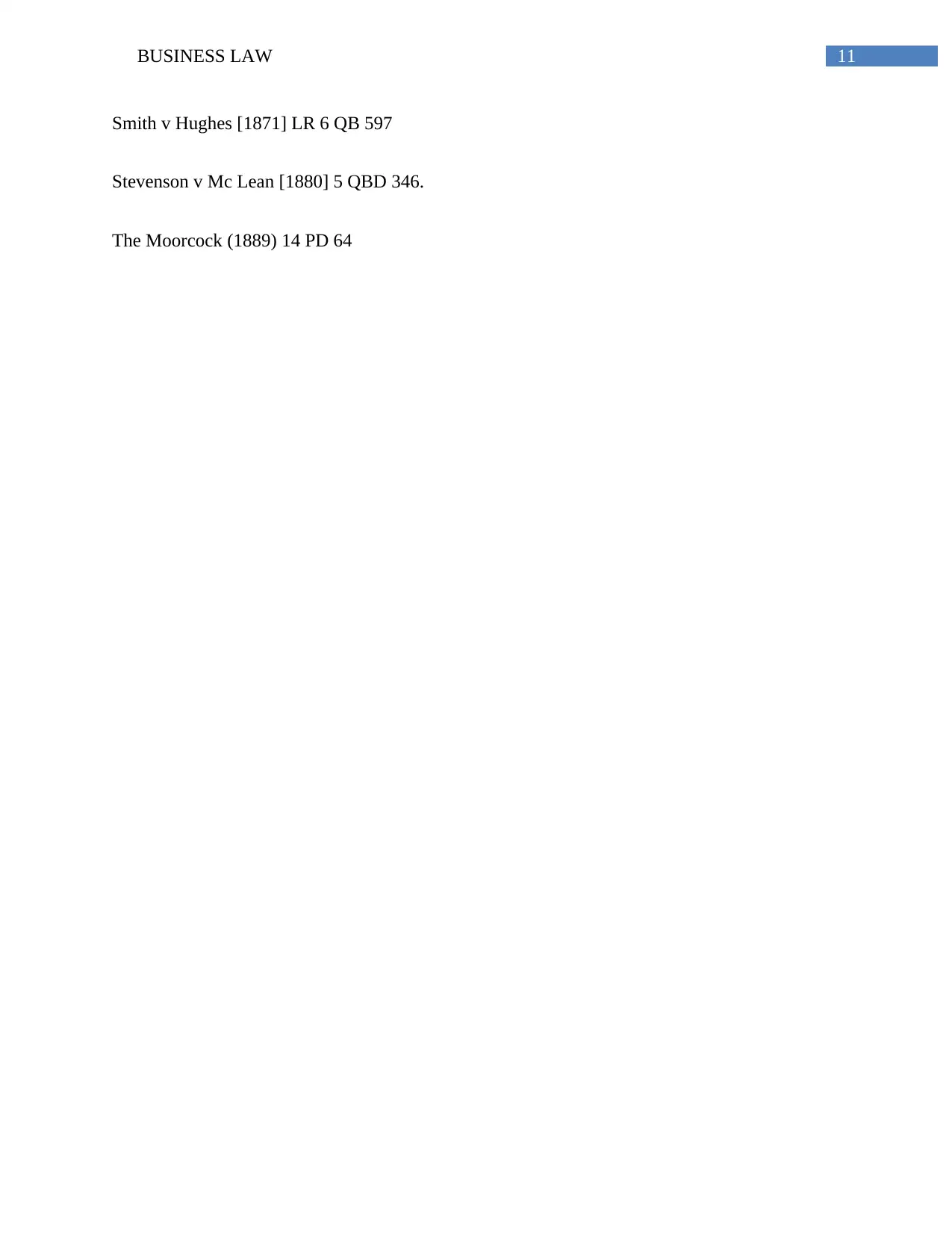
11BUSINESS LAW
Smith v Hughes [1871] LR 6 QB 597
Stevenson v Mc Lean [1880] 5 QBD 346.
The Moorcock (1889) 14 PD 64
Smith v Hughes [1871] LR 6 QB 597
Stevenson v Mc Lean [1880] 5 QBD 346.
The Moorcock (1889) 14 PD 64
⊘ This is a preview!⊘
Do you want full access?
Subscribe today to unlock all pages.

Trusted by 1+ million students worldwide
1 out of 12
Related Documents
Your All-in-One AI-Powered Toolkit for Academic Success.
+13062052269
info@desklib.com
Available 24*7 on WhatsApp / Email
![[object Object]](/_next/static/media/star-bottom.7253800d.svg)
Unlock your academic potential
Copyright © 2020–2025 A2Z Services. All Rights Reserved. Developed and managed by ZUCOL.





